Ancient Greek furniture might seem basic at first glance, but it was actually pretty smart.
Greeks didn’t clutter their homes with excess furniture. They focused on practicality, creating pieces that served multiple purposes. From simple wooden chairs to foldable beds, their designs were functional and versatile.
But that doesn’t mean they didn’t have style. Wealthier Greeks showed off with pieces like klinai couches featuring bronze details.
In this blog, you’ll get to know how Greek furniture influenced modern designs and how you can bring that simplicity and style into your home today. Ready to sit like the Greeks? Let’s get into it!
Why Greek Furniture is So Famous
Greek furniture gained its fame from its clean, basic, and useful design. Dating back to the 7th-4th century BC, Greek furniture stands out for its simple beauty without extra decorations. What makes Greek furniture special is the perfect mix of function and looks.
From the source materials, we can see that Greek homes were not filled with too many items. Their furniture showed a culture that valued moderation and practicality. Materials like wood, stone, reeds, metals, straws, and ivory were used to make these items.
The main types of Greek furniture included stools, couches (called klines), small tables, chests, and chairs. These pieces had careful craftsmanship with some carving and inlays, but were never too fancy. This balance helped Greek furniture styles stay popular through time.
Greek furniture also shows the culture’s focus on social life. For example, the kline was a bed used for both sleeping and dining during social events. This mix of uses shows how Greeks thought about space and social connections.
Today, many modern furniture makers still copy Greek styles, proving their lasting impact on design.
Materials & Craftsmanship In Greek Furniture
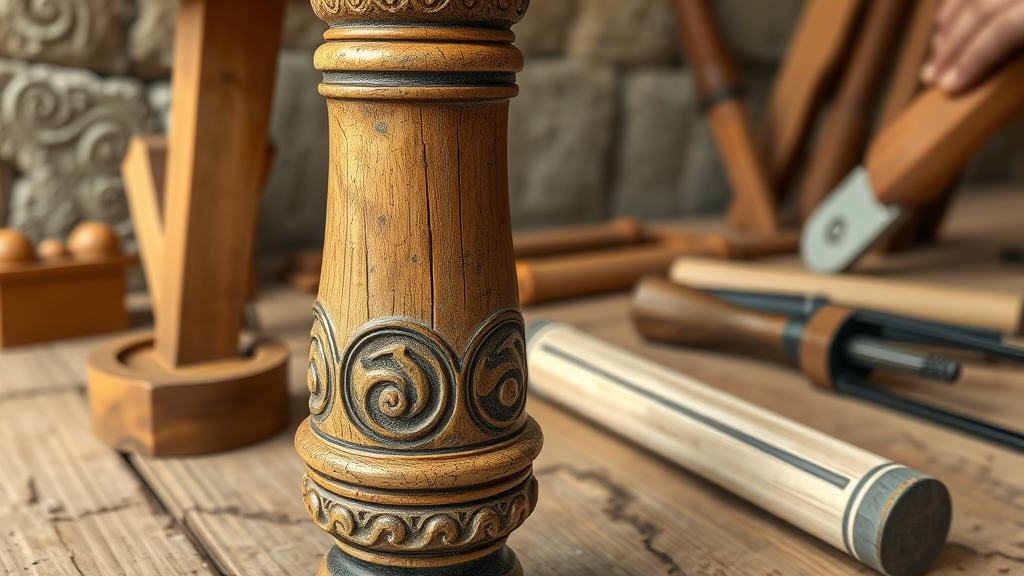
Greek furniture makers were picky about their materials. They didn’t just grab any old wood.
Woods: Oak, cedar, maple, and olive wood topped the list. These woods lasted long and looked good. The best pieces came from trees right in their backyard.
Metals: Bronze was the superstar metal. Greeks used it for legs, handles, and fancy details. Only rich folks could afford the shiny stuff.
Other Materials: Leather strips make seat bottoms comfy. Wealthier Greeks added ivory carvings or colorful cushions to show off.
Crafting: These ancient builders were seriously skilled. They joined wood without glue and bent it using heat and water.
Many pieces could fold up – the world’s first pack-and-go furniture. What’s funny is how much we still copy their ideas today. That IKEA chair? Thank a Greek craftsperson from 2,500 years ago.
Key Furniture Pieces and Their Uses
Ancient Greek homes had limited furniture types, focusing on function over excess. These basic items served multiple uses and showed the Greek values of simplicity and practicality. Their designs have stood the test of time and continue to influence modern furniture.
The Greeks kept things simple with just a few main furniture pieces. Let’s check them out.
Kline (Couch/Bed)
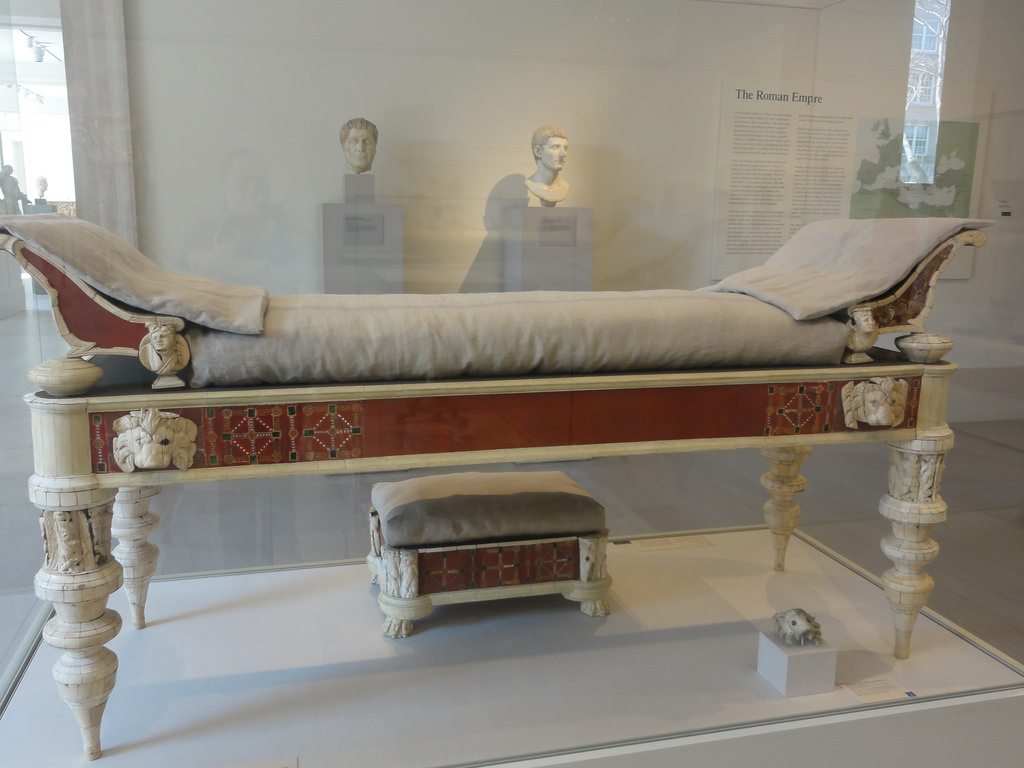
The kline was the major multi-tasker in Greek furniture. It wasn’t just a bed—it was also a lounging spot for meals. Greeks would use it at night for sleeping and during the day for reclining while eating.
They’d lie on their sides, propped up on one elbow, eating with the other hand. It was the perfect solution for relaxed dining, where formal table manners didn’t apply, making meals more about comfort and enjoyment than etiquette.
Klismos Chair
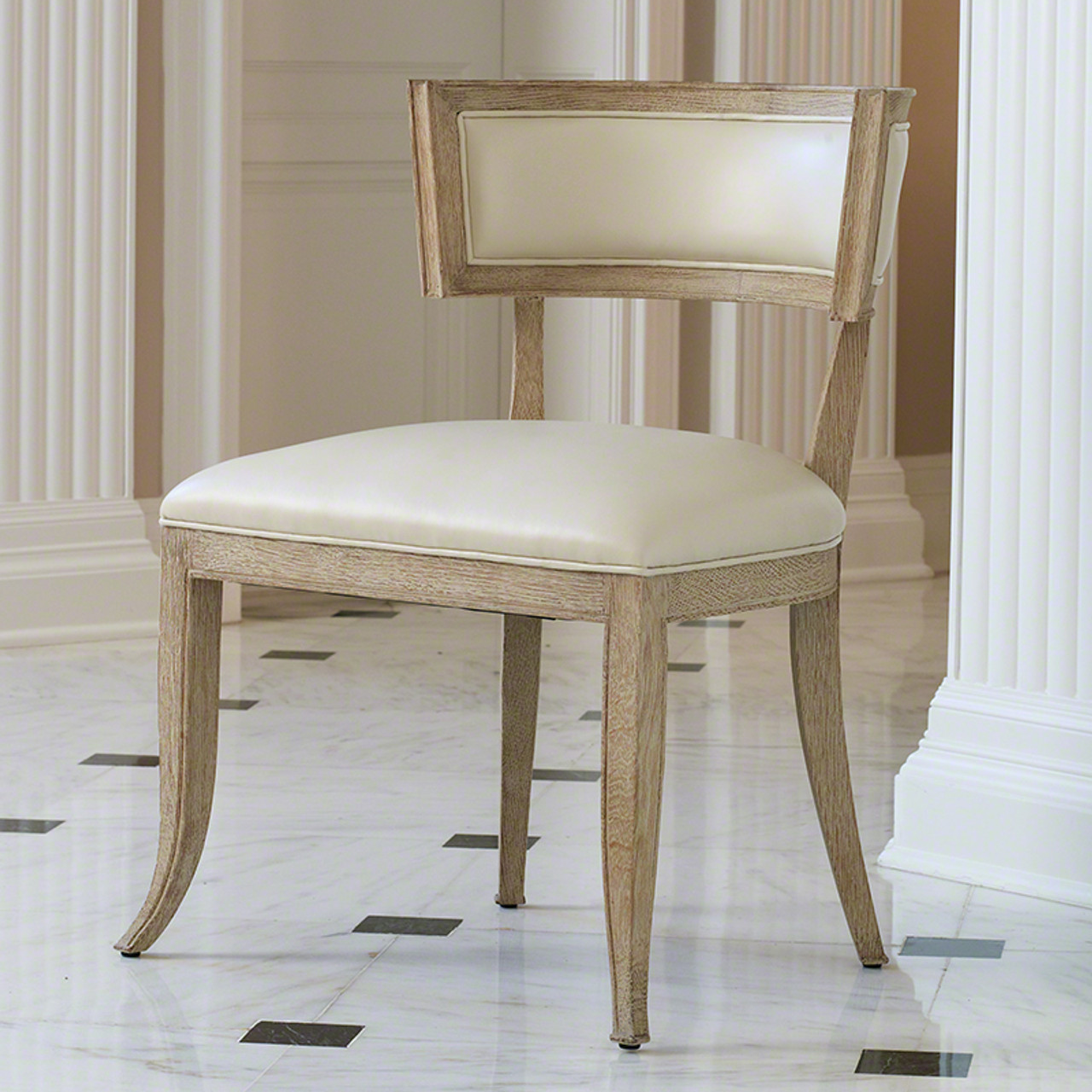
These were the trending ancient chairs. They had curved backs and legs that bent outward. Pretty fancy for 500 BC, wasn’t it? The Klismos chair stands out as one of the most famous Greek furniture designs.
Its graceful shape featured a wide, curved backrest and outward-splayed legs that looked both light and strong. This chair wasn’t just useful – it was a status symbol in Greek homes.
Artists often showed important people sitting in these chairs in their artwork. The design was so good that it is still copied today in modern furniture. Many current chairs with curved backs trace their roots back to this Greek creation.
Stools & Benches
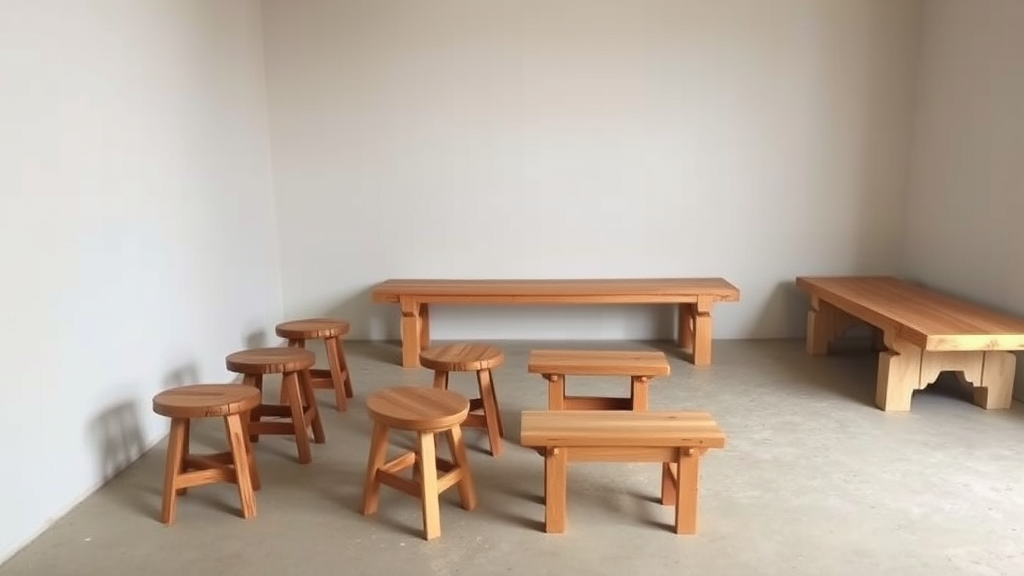
These were the go-to seats for most folks. Simple, small, and easy to move around when company came over. Stools and benches were common in most Greek households, making them the everyday seating choice for regular people.
These pieces were made from basic materials like wood and sometimes featured small cushions for comfort. Their main selling point was how easy they were to move and store. When hosting guests or during community events, Greeks could quickly rearrange these seats to create more space.
The basic design made them affordable for average citizens, unlike the more costly Klismos chairs. Some stools had three or four legs, while benches could seat multiple people at once.
Tables & Chests
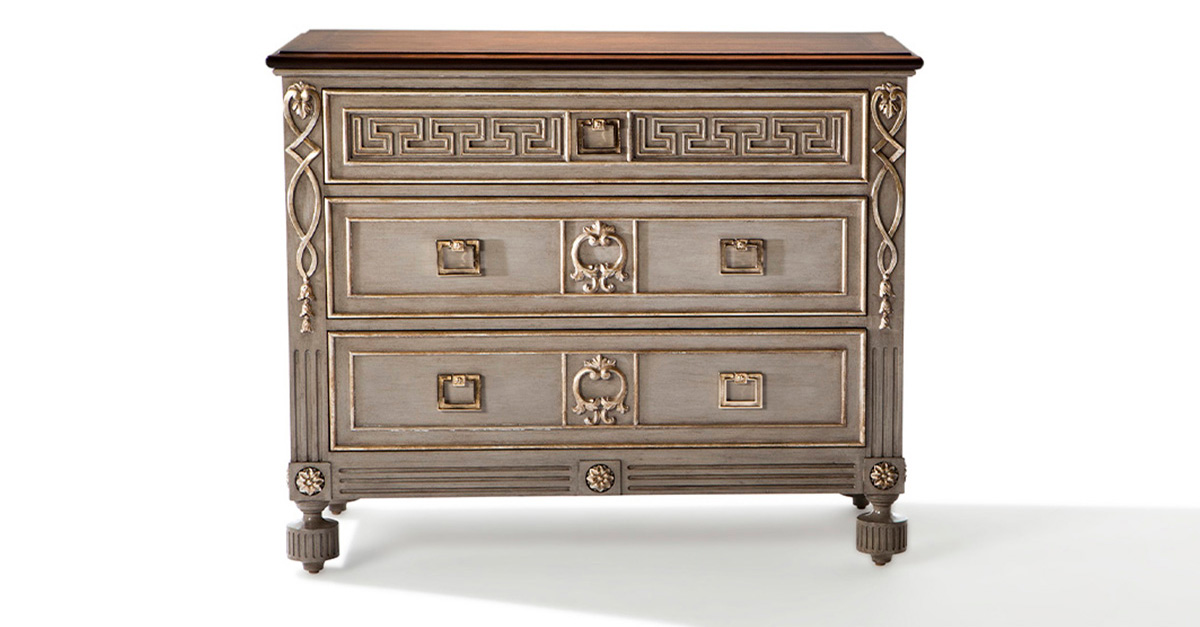
Greeks kept their stuff in wooden chests instead of closets. Their tables were small and low—perfect for eating while lounging on your kline. These tables weren’t the dining tables we know today. Most Greek tables stood only about knee-high since people would eat while reclining.
They were typically round with three legs and could be easily moved around as needed. Storage chests were essential in Greek homes for keeping clothes, linens, and valuables safe. Made primarily of wood, these chests sometimes featured decorative elements or simple carvings.
Some households had special chests called “larnakes” that could serve as both storage and seating. Wealthier Greeks might own chests with metal fittings or ivory inlays for a touch of luxury.
How to Add Greek Style to Your Home
Want to bring some ancient Greek style into your modern home? It’s easier than you think.
- Focus on simple, balanced designs with clean lines
- Look for furniture with X-shaped or curved legs
- Choose neutral colors with small touches of Mediterranean blue
- Add columns as decorative elements or use urns as vases
- Consider marble-topped tables or stone accents
- Incorporate Greek key patterns in throw pillows or rugs
- Arrange furniture in symmetrical, balanced pairs
- Mix in pottery with simple geometric patterns
- Use natural materials like wood, stone, and cotton
- Keep the overall look uncluttered and purposeful
Even a few small Greek-inspired pieces can give your space a classic, timeless feel without looking like a museum.
Design Principles of Greek Furniture
Greek furniture was all about less is more long before it was cool. Its makers loved simple shapes that made sense. The Greek approach to furniture design focused on clean lines and functional forms without extra decorations. Their craftsmen worked to create pieces that were both useful and good-looking.
Everything had to be balanced. If a curvy leg was on the left side of a chair, you’d find the same curve on the right. Greeks were serious about things looking even on both sides.
This symmetry wasn’t just for looks—it reflected the Greek belief in order and harmony in all things. Their furniture showed the same balance you’d see in their art and buildings.
The best Greek furniture borrowed ideas from their amazing buildings. Those fancy columns you see in temples? The same spiral patterns showed up on chair legs and table supports.
You could often spot architectural details like column capitals and fluting in household items. This connection between buildings and furniture created a consistent Greek visual style.
Plain wood was too boring for the Greeks. They jazzed things up with:
- Tiny pieces of different woods glued in patterns
- Carvings of animals, plants, and people
- Bright paint (red, blue, and gold were favorites)
Even their storage chests had style. Think of them as ancient Greek IKEA – built to last thousands of years. These weren’t just boxes for storing things- they were carefully made with attention to detail. The Greeks created furniture that has managed to influence design for centuries, proving that good design truly stands the test of time.
The Social Status of Greek Furniture
In Ancient Greece the furniture was symbolic of one’s wealth. Furniture clearly marked social standing in Greek society through materials and craftsmanship.
Privileged people lounged on fancy couches called klinai with expensive bronze legs and plush cushions. These pieces often included exotic materials like ivory and precious metals that only the elite could afford.
The less privileged sat on plain wooden stools or the floor. Common citizens made functional items from local woods without decoration.
Symposiums (fancy Greek dinner parties) were where furniture really showed off. Wealthy hosts arranged special couches in U-shapes so guests could chat while drinking wine and eating snacks.
Daily life was simpler. Most homes had basic tables for eating and working. Women often used special chairs for weaving- the Greek version of a home office.
The funny thing is that even the fanciest Greek furniture would seem pretty uncomfortable today. No recliners or memory foam! But those simple wooden pieces helped shape our thinking about furniture.
Comparison with Other Ancient Furniture Styles
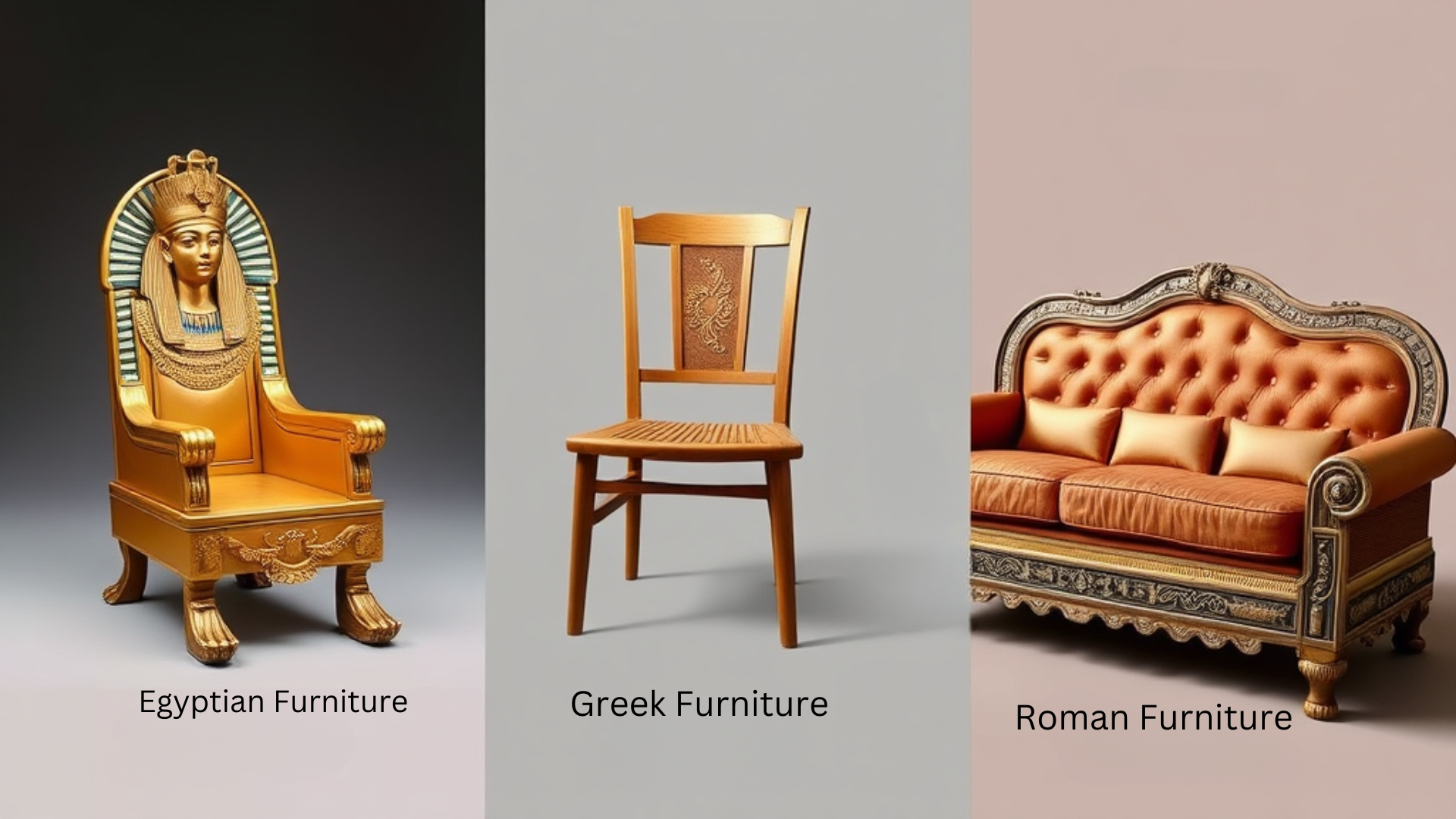
Let’s put these old chairs up against each other to see how they differ to each other.
| Feature | Egyptian Furniture | Greek Furniture | Roman Furniture |
|---|---|---|---|
| Time Period | Oldest of the three | Middle period | The latest of the three |
| Style | Flashy and formal | Simple and clean | Comfortable and fancy |
| Materials | Exotic woods, gold, ivory | Local timber, minimal decoration | Imported woods, metals, and fabrics |
| Distinctive Elements | Animal feet, gold details, built to last | Practical designs, minimal ornamentation | Greek-inspired but with added cushions and decorations |
| Purpose | Show wealth and status | Serve basic functions | Combine comfort with showing off |
| Famous Pieces | Throne chairs, decorative beds | Klismos chairs, klinai (couches) | Curule chairs, ornate couches |
| Construction | Solid and permanent | Often foldable and portable | Sturdy but luxurious |
| Design Philosophy | Make it impressive. | Keep it simple. | Make it comfortable and impressive. |
Egyptian furniture came first, with gold and fancy carvings built to last forever – just like their pyramids. Greek furniture came with simple wooden pieces that got the job done. Romans basically copied the Greeks but added their own flair with extra cushions and more showing off.
It’s funny to think people have been arguing about furniture styles for thousands of years.
Greek Influence on Modern Furniture
Look around your living room. See that clean-lined sofa or those X-shaped chair legs? You might be sitting on Greek ideas without knowing it.
Today’s furniture makers copy tons of Greek designs. The balanced proportions and simple forms that made Greek furniture special still show up in modern homes everywhere.
Those simple wooden chairs at IKEA? Greek influence. The curvy arms on fancy sofas? Yep, Greek, too.
Greek ideas show up everywhere because they just work. They’re simple, useful, and look good.
Want some Greek style at home? Check out places like Pottery Barn, West Elm, or even Target for affordable options.
Try specialty stores like Restoration Hardware or Design Within Reach for fancy stuff. The funny thing is, the ancient Greek people never knew their furniture ideas would last thousands of years.
Conclusion
Greek furniture offers us a window into a world that valued simplicity, balance, and purpose. From the multipurpose kline to Klismos chair, these designs have stood the test of time for good reason. They work, they look good, and they make sense.
Are you looking to add Greek touches to your home or just appreciate the history behind modern designs? There’s something special about this ancient approach to furniture.
What Greek-inspired furniture pieces do you have in your home? Share in the comments below! We’d love to see how you’ve incorporated these classic elements into your space.














